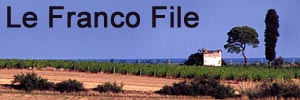Striking used to be called an English disease. In fact, it is much more of a maladie francaise, certainly these days. If it isn’t farmers blocking streets and burning foreign lamb imports, French truckers blocking autoroutes or French air traffic controllers refusing to control air traffic through their airspace, it’s French ferry workers throwing a strop and blockading ports. The latter had been going on for a week or so as we approached northern France for our return ferry today. Sometimes you seem to be better off not knowing that trouble is looming; at least that way you get on with enjoying yourself in blissful ignorance rather than fretting about it constantly. We knew about it.
It seems that the old Sea France ferry operation had somehow become part of Eurotunnel but that Eurotunnel had recently decided to sell off the ferry business, now called “My Ferry Link”, to DFDS. Horror of horrors, this sell off was done without consultation with the workers. Definitely time for une autre grève [another strike]. Roads were being blockaded, occasionally with tyres set alight, queues were being caused that illegal immigrant bastards were trying to capitalize on – all totally rational French stuff. As we approached Normandy yesterday for our last night, I had decided to try calling someone to find out what the form might be.
My first choice was the Caravan Club’s foreign travel service. It was Saturday; they only work on weekdays. Great!
My second choice was an out-of-office-hours P&O number, the company we were attempting to travel with. Eventually, I got through to a very helpful lady. I had suspected that the main action would be based on the motorway spur that connects the autoroute directly to the port of Calais. We thought we knew that trucks were stacking up in the UK trying to get to France and that the same would be happening in France with trucks trying to get to England. What we had no idea about was if anything was moving between Dover and Calais. My helpful lady told me that so far, all P&O services were operating to schedule, it was just DFDS/MyFerrryLink ships that were being stopped. She also suggested that we should approach Calais through the town because the actions were centred on the autoroutes. OK, maybe I’m rational after all. I felt better for having heard this but was still a little uncomfortable. we’d heard all sorts of stories about illegal immigrants doing unspeakable things to travellers in the middle of Calais. Nonetheless, the centre of Calais seemed the best plan.
That was just before the last toll both before Chartres where Francine paid the toll, went to wind up the window and “BANG!”, a report rather like a rifle shot. She nearly jumped through the sunroof. Her passenger window was, shall we say, buggered and stuck half open. The skies were darkening, too. Bother!
We made it to Normandy without further trouble and I managed to raise the window and wedge it closed – it fell down again if left unattended – with a disassembled wooden clothes peg. What worried me, of course, was the lack of security offered by an unsecured window in the centre of Calais.
We left early and hit the road for Calais, pegged window and all. We dived off the autoroute and entered the town guided by Sally Satnav. Our doors were locked but there’s was still that window. As it happened, we saw no sign of any low-life at all. The town route tips you out onto a roundabout immediately outside the perimeter of the ferry terminal. I thought I might see other returning holiday makers taking our route but no. Neither did we see any traffic spilling down the autoroute spur into the port. We did see a very long, slow line of traffic trying to get out of the port up onto the spur. There was no tailback of queuing traffic at passport control and no tailback of traffic at P&O check-in. We got on a boat an hour earlier than the one we’d booked. It all felt a little eerie.
Where there was a long tailback was at the newly modified Dartford Crossing back in good ol’ Blighty. I had paid my outbound and inbound DartCharges online before we left – at least, I hope I had. In an attempt to speed traffic through this major jaM25 bottleneck, the toll booths have been ripped out, number plate recognition cameras installed and pre/post-payment mechanisms put into place. How much this cost, I dread to think. I also hear that foreign traffic now tends not to bother to pay and that we can’t recoup the missing dosh, at least, not cost-effectively. Not only that but in my very limited experience of one mid-afternoon return trip from south to north of the Thames, it ain’t any bloody quicker.
Why? OK, here’s my theory. The back-up, at least going south-north, is not caused by the actual paying of the toll but by the funnelling of the lanes down into the two old carriageways of the Dartford Tunnel. The toll booths weren’t much of an issue at high traffic density because you simply paid whilst still waiting to get into the tunnels. It’s probably slightly quicker when the traffic is low but that wasn’t the problem that needed fixing, high traffic was. It was quick when we crossed the QEII Bridge going north-south 6 weeks ago but that was early on a Sunday morning – that was always quick even paying a toll. T’riffic!
We’re back. The passenger window is still wedged with a clothes peg.
















Recent Comments